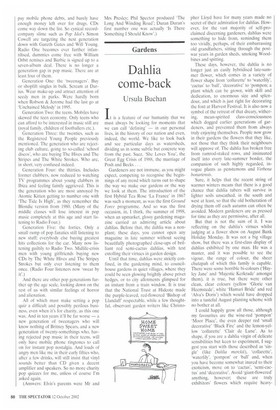Gardens
Dahlia come-back
Ursula Buchan
It is a feature of our humanity that we must always be looking for moments that we can call 'defining' — in our personal lives, in the history of our nation and even, indeed, the world. We like to look back and see particular days as watersheds, dividing us in some subtle but concrete way from the past. Suez. She Loves You', the Great Egg Crisis of 1988, the marriage of Posh and Becks . . .
Gardeners are not immune, as you might expect, competing to recognise the beginnings of any trend which turns out to shape the way we make our gardens or the way we look at them. The introduction of the first Hybrid Tea Rose 'La France' in 1867 was such a moment, as was the first Ground Force programme. And so was the first occasion, in, I think, the summer of 1998, when an upmarket, glossy gardening magazine carried an admiring article about dahlias. Before that, the dahlia was a nonplant; these days, you cannot open any magazine in late summer without seeing beautifully photographed close-ups of brilliant red semi-cactus dahlias, with text extolling their virtues in garden design.
Until that time, dahlias were strictly confined, in the gardening mind, to councilhouse gardens in quiet villages, where they could be seen glowing brightly above privet hedges, or to city allotments glimpsed for an instant from a train window. It is true that the National Trust at Hidcote made the purple-leaved, red-flowered 'Bishop of Llandaff' respectable, while a few thoughtful, observant garden writers like Christo pher Lloyd have for many years made no secret of their admiration for dahlias. However, for the vast majority of self-proclaimed discerning gardeners, dahlias were something to hide from, reminding them too vividly, perhaps, of their embarrassing old grandfathers, sitting through the postwar years in garden sheds, smoking Woodbines and spitting.
These days, however, the dahlia is no longer just an easily hybridised late-summer flower, which comes in a variety of flower shape from 'collarette' to `waterlily', 'cactus' to 'ball', 'decorative' to 'pompon; a plant which can be grown, with skill and dedication, to enormous size and splendour, and which is just right for decorating the font at Harvest Festival. It is also now a symbol of the retreat of that dreary, withering, mean-spirited class-consciousness which dogged earlier generations of gardeners, and prevented them from always truly enjoying themselves. People now grow in their gardens the flowers that they like, not those that they think their neighbours will approve of. The dahlia has broken free from ramrod-staked rows, and insinuated itself into every late-summer border, the companion of such highly regarded, invogue plants as penstemons and Verbena bonariensis.
Sure, it helps that the recent string of warmer winters means that there is a good chance that dahlia tubers will survive in lighter soils unscathed, in the south and west at least, so that the old botheration of drying them off each autumn can often be avoided. Modern gardeners are as pressed for time as they are permissive, after all.
But that is not the sum of it. I was reflecting on the dahlia's virtues whilst judging at a flower show on August Bank Holiday Monday. It was not a big village show, but there was a first-class display of dahlias exhibited by one man. He was a master, and it was possible to see the vigour, the range of colour, the sheer chutzpah of which this family is capable. There were some horrible hi-colours (`Hayley Jane' and 'Majestic Kerkrade' amongst them), it is true, but there were other clean, clear colours (yellow `Glorie van Heemstede', white 'Hamari Bride' and red 'Alva's Doris') which would have dropped into a tasteful August planting scheme with no bother at all.
I could happily grow all those, although my favourites are the wine-red 'pompon' 'Moor Place', the even deeper red 'small decorative' Black Fire' and the lemon-yellow `collarette"Clair de Lune'. As to shape, if you are a dahlia virgin of delicate sensibilities but keen to experiment, I suggest you start with those described as 'single' (like Dahlia merckii), `collarette', `waterlily', 'pompon' or 'ball' and, when you have become somewhat inured to their exoticism, move on to 'cactus', 'semi-cactus' and 'decorative'. Avoid 'giant-flowered. anything, however; these are truly exhibitors' flowers which require heavy
duty staking and growing under shelters to preserve the heads of the ten-inch flowers.
Now that the dahlia is so satisfactorily rehabilitated, all that gardeners need to do is to rescue the 'florist's chrysanthemum' from the ugly polythene tunnel ghetto to which it has been consigned, and prize it for the fine, sturdy, colourful pot-plant that it can he, Not long ago, it may have seemed that chrysanths were for ever destined only for flower-show benches and cemeteries. But that was then, and this is now.



































































































 Previous page
Previous page